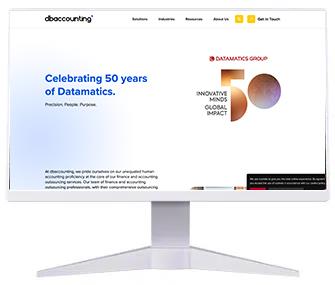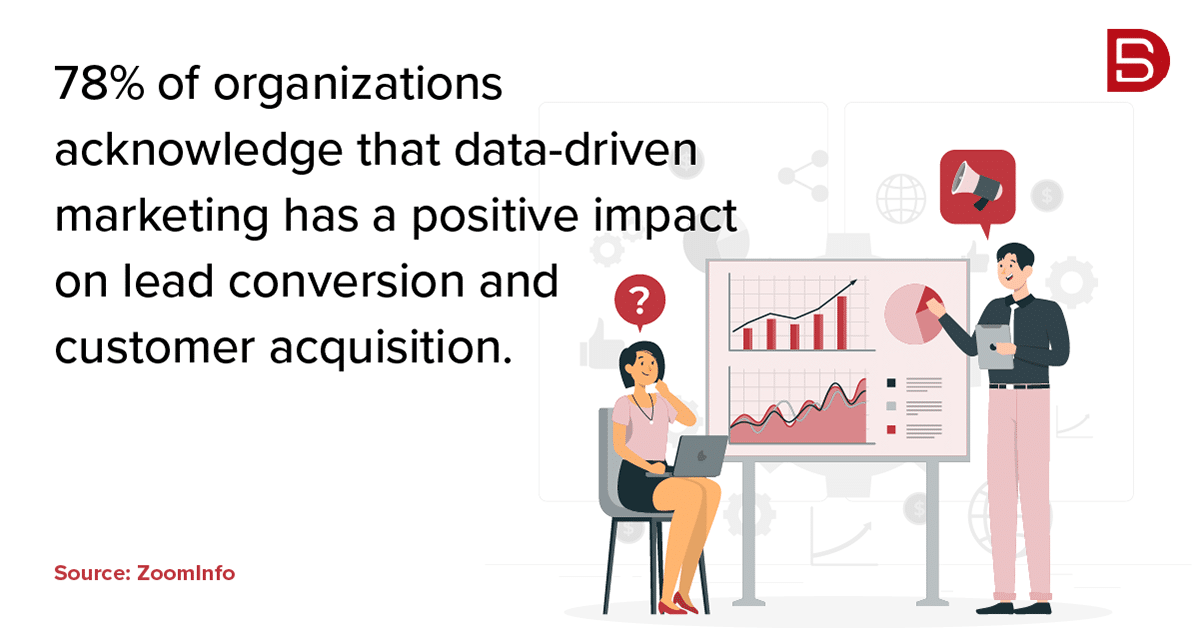While data-driven marketing may sound complex, it is actually quite straightforward once you remove the technical jargon surrounding it. It’s all about using customer information to shape your marketing strategies. Gone are the days of relying on hunches or old-school marketing methods, today’s marketers are turning to customer data as their most reliable source of insight.
Data-driven marketing helps you communicate with your potential customers using data. You listen to what the data reveals about their preferences, behaviors, and needs, and then you tailor your marketing efforts accordingly. This approach is more precise and effective because it’s based on real insights rather than guesswork.
What is Data-Driven Marketing?
Data-driven marketing is a strategic approach where brands utilize B2B customer data to refine their messaging and advertising efforts. This involves analyzing and harnessing data to gain insights into the preferences, requirements, and anticipated behaviors of their target audience.
By delving into this data, data-driven marketers gain a deeper understanding of their customers. This understanding goes beyond basic demographics and extends to factors like past purchase history, online behavior, and engagement with marketing materials. Such insights are invaluable in crafting marketing strategies that are highly tailored to individual customer segments.
The ultimate goal of data-driven marketing is to maximize the return on investment (ROI). To achieve this, marketers use the gathered insights to develop marketing plans that resonate with specific customer segments. Instead of employing a one-size-fits-all approach, these plans are personalized, ensuring that each customer receives messages and offers that align with their preferences and needs.
Traditional Marketing Vs. Data-Driven Marketing
Both traditional and data-driven marketing share the common objective of attracting a target audience and persuading them to make a purchase. However, what sets them apart are their methodologies and approaches.
Traditional Marketing:
Traditional marketing encompasses all non-digital marketing activities. This includes conventional methods such as print, broadcast, direct mail, telephone outreach, and outdoor advertising like billboards and yard signs. Traditional marketing often relies on personal experiences and intuition rather than data-driven insights to craft messages for specific demographics. It employs a range of techniques like newspaper ads, radio, and TV commercials to reach its intended audience.
Data-Driven Marketing:
Data-driven marketing, on the other hand, places data at the core of its marketing strategies. It involves using data as the primary resource for making informed marketing decisions. Marketing professionals nowadays leverage data to:
- Determine the types of content that resonate best with online audiences.
- Evaluate the effectiveness of audience segmentation in attracting the right demographic and motivating desired actions.
- Access data from various platforms, including smart TVs, social media, phone networks, and web browsers.
Data-driven marketing tends to deliver superior results with lower costs and higher profit margins compared to traditional marketing. It not only reduces expenses but also reaches a broader audience, ultimately helping businesses increase revenue while keeping costs in check.
How Data-Driven Marketing Boosts Business Performance
1. Enhanced Audience Targeting
One of the great things about data-driven marketing is that it brings you closer to your audience. In fact, it lets you speak to them directly.
With data-driven marketing, marketers get to really know their target audience. How? By diving into customer history data and using those insights to make their interactions with clients even better. It’s like having a chat with your customers and truly understanding what makes them tick.
2. Strengthening Customer Connections through Data
Data empowers marketers to create deeper connections with potential customers, and they can do it on a large scale. For instance, marketers could run campaigns that adapt in real-time based on how a customer interacts with it.
This means they can consistently deliver a campaign that perfectly aligns with what their target audience expects. It helps in having a dynamic conversation with your customers, always staying in tune with their preferences.
3. Discovering Optimal Promotion Channels
Data doesn’t just reveal what your target audience likes; it also suggests which platforms your brand should use to connect with customers today and tomorrow.
This insight helps you put your message where your intended audience is or will be shortly. It helps b2b marketers reach customers precisely where they are or will be in the future.
4. The Power of Personalization
In today’s marketing landscape, generic messages no longer cut it with customers. A study found that 74% of customers get frustrated when they see irrelevant content from brands. Furthermore, 79% of them won’t even consider an offer unless it’s personalized based on their past interactions.
So, to truly connect with customers, marketers need to prioritize personalization. Here’s how data makes it happen:
First, it gives you a complete picture of your target audience. It helps you understand what makes potential customers tick and what issues matter to them. With individual customer insights, you can take your communication to the next level.
Does it pay off? Absolutely. According to InvestP, businesses that embrace personalization enjoy 5x to 8x higher ROI from their marketing efforts. It helps you speak directly to each customer’s needs and preferences, and the results speak for themselves.
Creating a Data-Driven Marketing Strategy: A Quick Guide
We understand that developing a data-driven strategy is a broad subject, one that could fill an entire guide. Nevertheless, we believe it’s valuable for you to have a glimpse of the process. Here’s a concise overview of how to establish a data-driven strategy:
Step 1: Define Your Data Objectives
Before diving into data collection, it’s crucial to set clear objectives for what you aim to achieve with the data. Similar to the companies mentioned earlier, you need to establish a specific goal for the data. Why is this important? Well, your objectives serve as the compass guiding your next actions. They dictate what data you should gather, where to find it, and what insights to seek.
Step 2: Collecting the Data
Once you’ve defined your data objectives, the next step is to pinpoint the information you need to gather. Review your goals and think about what data would best inform your strategy. Afterward, identify the sources or places where you can access this data.
Step 3: Acquiring and Organizing Your Data
This step is a pivotal one, and it involves two key actions:
- Choosing the Right Data Platform: First and foremost, you need to decide on the ideal data platform. This platform will serve as the backbone of your data strategy, helping you seamlessly organize and structure the information you collect. Think of it as the toolbox that empowers you to manage your data efficiently.
- Collecting Data from Various Sources: With your chosen data platform in place, it’s time to start gathering information. This data can come from a multitude of sources, such as customer databases, website analytics, social media platforms, or market research. The goal here is to collect a diverse range of data that aligns with your objectives.
By taking these steps, you ensure that your data is not only accessible but also well-organized, setting the stage for the next phases of your data-driven marketing strategy.
Step 4: Assembling Your Team or Expanding Capabilities
Your data-driven journey may necessitate the formation of a dedicated team or the enhancement of existing in-house or external capabilities. This decision should align with your specific goals and objectives.
Here’s where partnering with a B2B data provider could be particularly beneficial. These providers specialize in sourcing high-quality, up-to-date business data. By teaming up with one, you can tap into their expertise and access a wealth of valuable data that might be challenging to gather on your own.
Step 5: Evaluating & Monitoring Progress
In the final stage of your strategy, it’s crucial to establish a systematic process for assessing the performance of your campaign. This serves a dual purpose: not only does it allow you to thoroughly analyze your efforts, but it also enables you to report progress to stakeholders effectively.
Conclusion
In today’s fiercely competitive digital world, using data-driven marketing isn’t just a choice; it’s a must-have for businesses looking to succeed.
By harnessing data-driven solutions, marketers can optimize their budgets, boost ROI and profits, and gain valuable insights into their marketing efforts. If you’re interested in turning data-driven marketing into a strategic advantage, reach out to us at marketing@datamaticsbpm.com. Our B2B contact database is packed with firmographics, technographics, and organizational details, ready to power your next digital marketing campaign.
 Select an element to maximize. Press ESC to cancel.
Select an element to maximize. Press ESC to cancel.
Henry Romano



